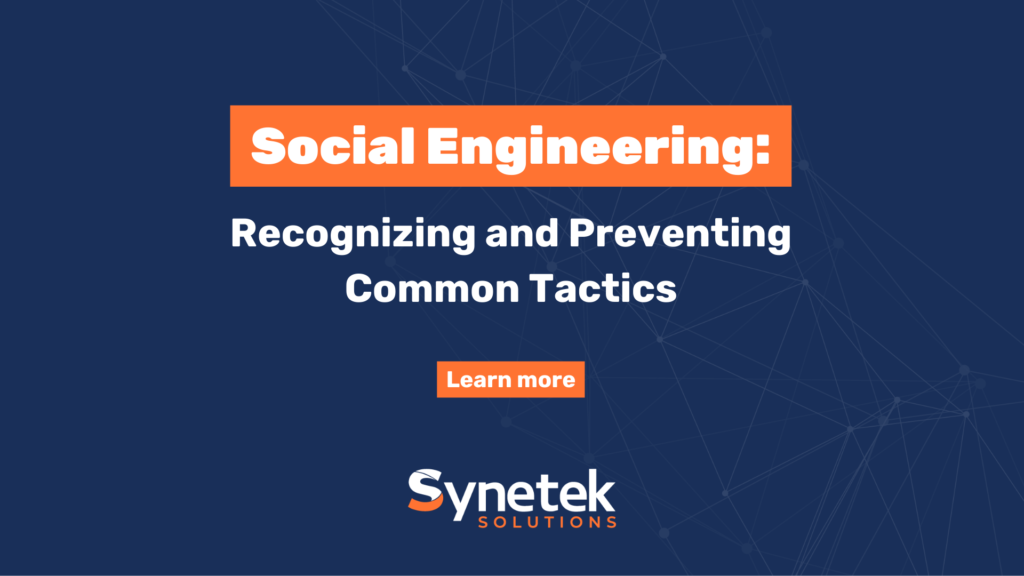
In today’s interconnected world, businesses have become prime targets for cybercriminals. While advanced security measures are essential, on the business side they are typically addressed by a good IT provider, cyber attackers often exploit a different vulnerability – human behavior.
Social engineering is a cunning technique cybercriminals employ to manipulate and deceive individuals into divulging sensitive information or performing actions that compromise security. In other words, even with advanced security in terms of systems, it is many times a human on the inside that is coerced to help the cyber criminal get in.
In this blog post, we will explore the trending topic of social engineering and its common tactics and provide practical advice to help your business safeguard against these threats.
Understanding Social Engineering
Social engineering manipulates human psychology to gain unauthorized access to confidential data or exploit a business’s weaknesses.
Cybercriminals use various tactics to achieve their malicious objectives. Let’s take a closer look at some common social engineering tactics:
Phishing Attacks: One of the most prevalent forms of social engineering, phishing, involves sending deceptive emails or messages impersonating trusted sources. These messages often contain malicious links or attachments, tricking recipients into revealing sensitive information or login credentials.
Pretexting: In pretexting attacks, attackers create a fabricated scenario to obtain personal or confidential information from individuals. They may pose as coworkers, vendors, or even IT support personnel to deceive targets into divulging crucial data.
Baiting: Cybercriminals use enticing offers or fake incentives to lure employees into downloading malicious software or giving away sensitive information. Baiting attacks often exploit employees’ curiosity and desire for rewards.
Quid Pro Quo: In this tactic, attackers promise a benefit or service in exchange for information. For instance, they may claim to be conducting a survey and offer a reward for participating, extracting valuable data.
Tailgating: Physical access is just as crucial to social engineering as digital access. Tailgating occurs when an unauthorized person gains entry to a restricted area by following an authorized individual through access points like secure doors or checkpoints.
Tips to Combat Social Engineering
Employee Training: Ensure that all employees, from top management to front-line staff, undergo regular cybersecurity training. Educate them about the latest social engineering tactics, warning signs, and the importance of not sharing sensitive information with unknown sources.
Implement Strong Authentication: Enforce multi-factor authentication (MFA) for all critical accounts and systems. MFA adds an extra layer of security by requiring users to verify their identity through multiple means, making it harder for attackers to gain unauthorized access.
Establish Strict Data Handling Policies: Implement policies that clearly outline how sensitive information should be treated, stored, and shared. Regularly remind employees of these policies and ensure they understand the consequences of non-compliance.
Regular Security Audits: Conduct periodic security audits to identify and address vulnerabilities promptly. Regular assessments can help spot potential weaknesses that social engineers may target.
Keep Software Updated: Outdated software can be exploited by cybercriminals. Regularly update all software and applications to protect against known vulnerabilities.
Social engineering attacks are sophisticated and often difficult to detect. They prey on human psychology and the natural inclination to trust others.
Recognizing and preventing these tactics is essential for the security and success of your business. By staying informed, training employees, and implementing robust security measures, you can fortify your defenses against social engineering threats.
As a trusted provider of Managed IT Services, we understand the evolving landscape of cyber threats. We use a multi-level approach to cyber-security by employing not only the latest technology and continuous network monitoring but also by taking into account the human factor and including ongoing cyber-security training and testing of our users on their cyber-security knowledge and preparedness to identify a threat.
Contact us today to schedule a FREE consultation and learn how we can help protect your business from social engineering attacks.
Don’t let your guard down; secure your business with expert IT solutions!











